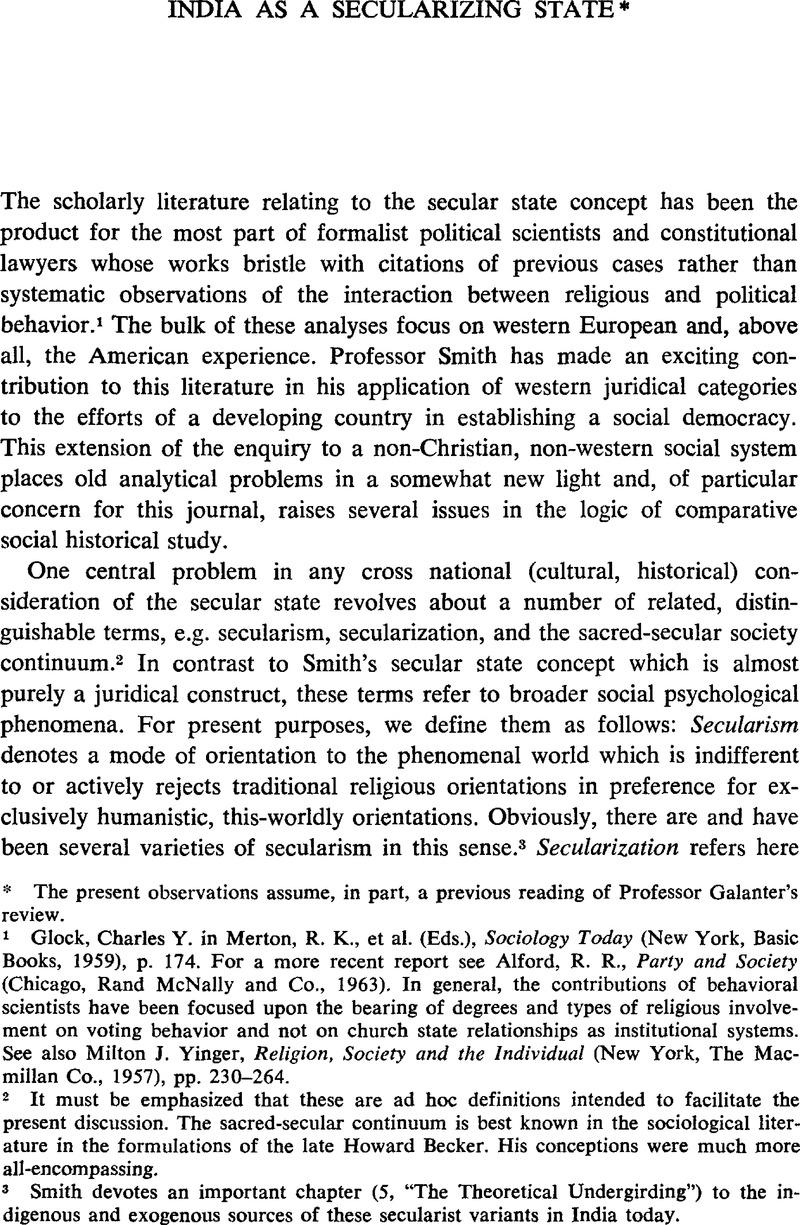No CrossRef data available.
Article contents
India as a Secularizing State*
Published online by Cambridge University Press: 03 June 2009
Abstract

- Type
- Debate: Secularism East and West
- Information
- Copyright
- Copyright © Society for the Comparative Study of Society and History 1965
References
1 Glock, Charles Y. in Merton, R.K. et al. (Eds.), Sociology Today (New York, Basic Books, 1959), p. 174.Google Scholar For a more recent report see Alford, R.R., Party and Society (Chicago, Rand McNally and Co., 1963).Google Scholar In general, the contributions of behavioral scientists have been focused upon the bearing of degrees and types of religious involvement on voting behavior and not on church state relationships as institutional systems. See also Yinger, Milton J., Religion, Society and the Individual (New York, The Macmillan Co., 1957), pp. 230–264.Google Scholar
2 It must be emphasized that these are ad hoc definitions intended to facilitate the present discussion. The sacred-secular continuum is best known in the sociological literature in the formulations of the late Howard Becker. His conceptions were much more all-encompassing.
3 Smith devotes an important chapter (5, “The Theoretical Undergirding”) to the indigenous and exogenous sources of these secularist variants in India today.
4 This phrasing deliberately exaggerates (and thereby distorts) certain features of Smith's presentation of his secular state concept in order to highlight his relative lack of attention to the impact of non-juridical elements on the state and the individual particularly at the village level. This is characteristic of the formalist approach which Smith approximates most particularly in his insistence on the wall of separation dimension of his construct. It would be instructive, for example, to apply his concept to a comparative study of Ireland and Norway as secular and non-secular states respectively. There is a rather sizeable, largely polemical literature on the Irish case, e.g. Blanshard, Paul, The Irish and Catholic Power, An American Interpretation (Boston, The Beacon Press, 1953).Google Scholar For some notes on the Norwegian case, see Flint, John T., “The Church in Relation to Family Life”, in Eliot, Thomas D. and Hillman, Arthur, Eds., Norway's Families (The University of Pennsylvania Press, 1960),Google Scholar Chapter XVIII.
5 E.g., William J., Goode, Religion Among the Primitives, The Web of Religion and Sex, Economics and Politics (Glencoe, Free Press, 1951).Google ScholarMarriott, McKim (Ed.), Village India, Studies in the Little Community (Chicago, 1955).Google ScholarBendix, Reinhard, Max Weber: An Intellectual Portrait (Garden City, New York, Doubleday and Co., Inc., 1960), pp. 310–329.Google Scholar
6 Drawn from a summary table of his discussion, p. 40.
7 ibid. It would seem that these variable dimensions are neither of equal weight as “causal” factors nor mutually exclusive.
8 The historical literature on this vast area is of course tremendous. Max Weber's work and the literature of controversy inspired by it continues to be of central importance. A recent addition to efforts here is, J. R. Strayer, “The State and Religion: An Exploratory Comparison in Different Cultures, Greece and Rome, The West, Islam”, and Coulborn, R., “The State and Religion: Iran, India, and China”, in Comparative Studies in Society and History, Vol. I, No. 1, pp. 38–57.Google Scholar
9 Smith, pp. 155–456. (Italics added.)
10 Ibid., p. 495. (Italics added.)
11 Ibid., pp. 499–501.
12 Ibid. “The Orthodox Hindu is strongly inclined to the opinion that the government's all-out attack on untouchability constitutes an interference with his freedom of religion. His interpretation of the state's policy will resemble the following: The present government is for the most part a godless one, having rejected the counsel and commands of the Hindu Shastras. The secularizing state seeks to impose its own social pattern in place of the divinely ordained pattern of the caste system. The state attacks caste and hence, Hindu religion (for the two are inextricably tied together) while regimenting the individual in religio-social matters”, p. 308.
13 Professor Galanter has examined this problem very thoroughly in his analysis.
14 Shils, E., “Political Developments in the New States”, Comparative Studies in Society and History, Vol. II, pp. 265–292, 379–411.Google Scholar Reissued in book form, Mouton and Company, The Hague, 1962.
15 Almond, G.A., and Coleman, James S. (Eds.), The Politics of the Developing Areas (Princeton, New Jersey, Princeton University Press, 1960).Google Scholar
16 Hagen, E.E., Toward A Theory of Social Change (Homewood, Illinois, The Dorsey Press, 1962).Google Scholar


